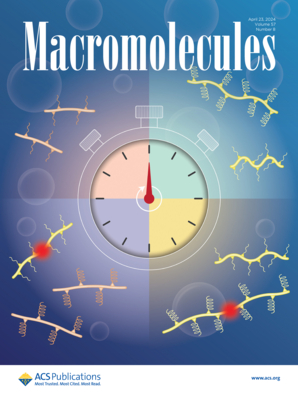为什么序列阻塞会加剧杂聚合物中的线圈-球体转变
IF 5.2
1区 化学
Q1 POLYMER SCIENCE
引用次数: 0
摘要
单链聚合物中的线圈-球体转变是聚合物物理学的基石。尽管人们对均聚物的理解已经非常透彻,但对于仅由两种非离子单体组成的共聚物来说,这一过程却要复杂得多,因为它们构象变化的位置,尤其是锐度(合作性),与序列高度相关。在这项研究中,我们提出了具有规则序列的中性 AB 共聚物中线圈-球状转变的统计理论。为了描述初级结构的作用,我们超越了平均场近似,计算了由于 A 和 B 单体之间的化学差异(不相容性)而产生的高斯波动修正。局部成分波动降低了单体相互作用的第二和第三维里系数;这些修正是以一般形式发现的,并为嵌段长度为 m 的嵌段交替链提供了闭式表达式。结果表明,增加单体嵌段度会:(i) 使球体更致密;(ii) 使构象转变转移到更高温度;最重要的是:(iii) 缩小转变区域。当球内微相分离伴随或紧随球内微相分离时,塌缩现象会强烈加剧。所提出的理论有助于全面理解高分子的序列可调构象行为,包括霍赫洛夫-哈拉特蛋白共聚物形成的具有核壳微结构的球状物。本文章由计算机程序翻译,如有差异,请以英文原文为准。

Why Sequence Blockiness Sharpens Coil–Globule Transition in Heteropolymers
Coil–globule transition in a single-chain polymer is the cornerstone of polymer physics. Although completely understood for homopolymers, it turns out to be much more sophisticated for copolymers of mere two nonionic monomers because the position and especially sharpness (cooperativity) of the conformational change in them are highly sequence-dependent. In this work, the statistical theory of coil–globule transition in neutral AB copolymers with regular sequences is developed. To describe the role of the primary structure, we go beyond the mean-field approximation and calculate the Gaussian fluctuation correction due to chemical differences (incompatibility) between A and B monomers. Local compositional fluctuations reduce the second and third virial coefficients of monomer interactions; these corrections are found in the general form, and closed-form expressions are provided for block-alternating chains with the block length m. For nonperiodic sequences, the found corrections are annealed averages. Increasing the monomer blockiness is shown to (i) make the globule denser, (ii) shift the conformational transition to higher temperatures, and, most importantly, (iii) narrow the transition region. The collapse sharpens strongly when accompanied or shortly followed by intraglobular microphase separation. The developed theory contributes to a comprehensive understanding of the sequence-tunable conformational behavior of macromolecules, including Khokhlov–Khalatur protein-like copolymers forming globules with the core–shell microstructure.
求助全文
通过发布文献求助,成功后即可免费获取论文全文。
去求助
来源期刊

Macromolecules
工程技术-高分子科学
CiteScore
9.30
自引率
16.40%
发文量
942
审稿时长
2 months
期刊介绍:
Macromolecules publishes original, fundamental, and impactful research on all aspects of polymer science. Topics of interest include synthesis (e.g., controlled polymerizations, polymerization catalysis, post polymerization modification, new monomer structures and polymer architectures, and polymerization mechanisms/kinetics analysis); phase behavior, thermodynamics, dynamic, and ordering/disordering phenomena (e.g., self-assembly, gelation, crystallization, solution/melt/solid-state characteristics); structure and properties (e.g., mechanical and rheological properties, surface/interfacial characteristics, electronic and transport properties); new state of the art characterization (e.g., spectroscopy, scattering, microscopy, rheology), simulation (e.g., Monte Carlo, molecular dynamics, multi-scale/coarse-grained modeling), and theoretical methods. Renewable/sustainable polymers, polymer networks, responsive polymers, electro-, magneto- and opto-active macromolecules, inorganic polymers, charge-transporting polymers (ion-containing, semiconducting, and conducting), nanostructured polymers, and polymer composites are also of interest. Typical papers published in Macromolecules showcase important and innovative concepts, experimental methods/observations, and theoretical/computational approaches that demonstrate a fundamental advance in the understanding of polymers.
 求助内容:
求助内容: 应助结果提醒方式:
应助结果提醒方式:


